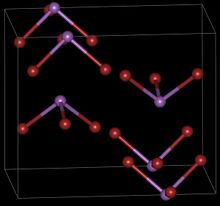Chemistry:Antimony tribromide

| |
| Names | |
|---|---|
| IUPAC name
tribromostibane
| |
| Other names
Antimony(III) bromide
| |
| Identifiers | |
3D model (JSmol)
|
|
| ChemSpider | |
| EC Number |
|
PubChem CID
|
|
| RTECS number |
|
| UNII | |
| UN number | 1549 |
| |
| |
| Properties | |
| SbBr3 | |
| Molar mass | 361.472 g/mol |
| Appearance | colorless to yellow crystals hygroscopic |
| Density | 4.35 g/cm3 |
| Melting point | 96.6 °C (205.9 °F; 369.8 K) |
| Boiling point | 288 °C (550 °F; 561 K) |
| soluble,partial hydrolysis | |
| Solubility | soluble in dilute HCl, HBr, CS2, acetone, benzene, chloroform, ammonia, alcohol |
| -115.0·10−6 cm3/mol | |
Refractive index (nD)
|
1.74 |
| 2.47 D | |
| Structure | |
| Orthorhombic, oP16, SpaceGroup = Pnma, No. 62 (β form) | |
| Thermochemistry | |
Heat capacity (C)
|
96 J/mol K |
Std enthalpy of
formation (ΔfH⦵298) |
-259 kJ/mol |
| Hazards | |
| GHS pictograms |  
|
| GHS Signal word | Warning |
| H302, H332, H411 | |
| P261, P264, P270, P271, P273, P301+312, P304+312, P304+340, P312, P330, P391, P501 | |
| Lethal dose or concentration (LD, LC): | |
LD50 (median dose)
|
7000 mg/kg |
| NIOSH (US health exposure limits): | |
PEL (Permissible)
|
TWA 0.5 mg/m3 (as Sb)[1] |
REL (Recommended)
|
TWA 0.5 mg/m3 (as Sb)[1] |
Except where otherwise noted, data are given for materials in their standard state (at 25 °C [77 °F], 100 kPa). | |
| Infobox references | |
Antimony tribromide (SbBr3) is a chemical compound containing antimony in its +3 oxidation state.
Production
Antimony tribromide may be made by the reaction of antimony with elemental bromine, or by the reaction of antimony trioxide with hydrobromic acid.
Alternatively, it can be prepared by the action of bromine on a mixture of antimony sulfide and antimony trioxide at 250 °C.
Chemical properties
Antimony tribromide has two crystalline forms, both having orthorhombic symmetries. When a warm carbon disulfide solution of SbBr3 is rapidly cooled, it crystallizes into the needle-like α-SbBr3, which then slowly converts to the more stable β form.[2]
Antimony tribromide hydrolyzes in water to form hydrobromic acid and antimony trioxide:
- 2 SbBr3 + 3 H2O → Sb2O3 + 6 HBr
Uses
It can be added to polymers such as polyethylene as a fire retardant.[3] It is also used in the production of other antimony compounds, in chemical analysis, as a mordant, and in dyeing.[4]
References
- ↑ 1.0 1.1 NIOSH Pocket Guide to Chemical Hazards. "#0036". National Institute for Occupational Safety and Health (NIOSH). https://www.cdc.gov/niosh/npg/npgd0036.html.
- ↑ Okuda, Tsutomu; Terao, Hiromitsu; Ege, Osamu; Negita, Hisao (1970). "Structural Studies of Antimony Tribromide and Its Molecular Complex with Benzene by Means of the 81Br Nuclear Quadrupole Resonance". Bulletin of the Chemical Society of Japan 43 (8): 2398. doi:10.1246/bcsj.43.2398.
- ↑ Yang, Y. P.; D. G. Brewer; J. E. S. Venart (1991). "A study of the synergistic action of antimony oxide in fire-retardant polyethylene". Fire and Materials 15: 37–42. doi:10.1002/fam.810150107.
- ↑ "Antimony tribromide" http://cameochemicals.noaa.gov/chemical/2501
 |

